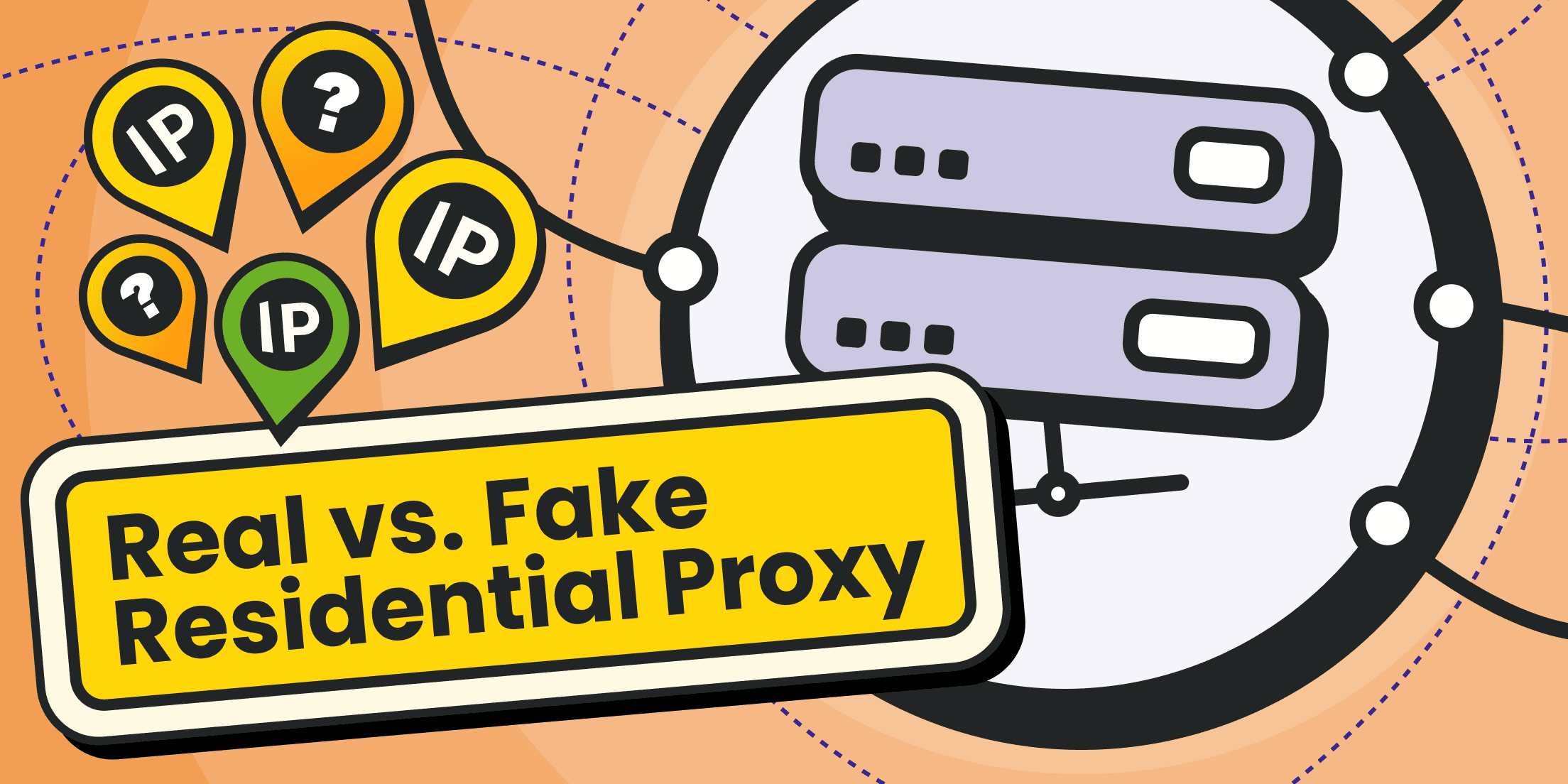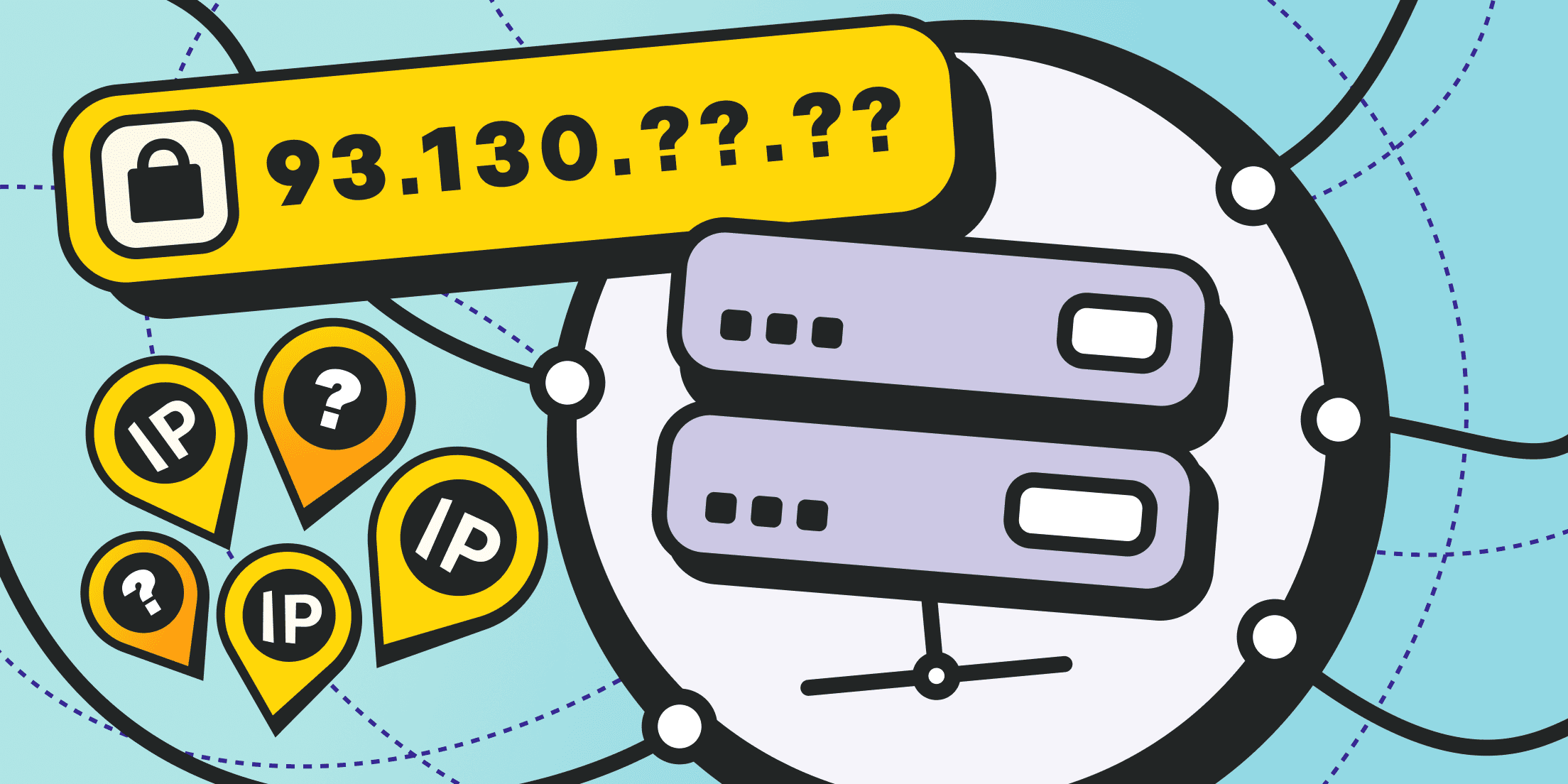Under the “residential proxies” label, you can end up with IPs very different from what you paid for. You subscribe to a (non-)residential IP address, and in return get CAPTCHA, bans, and unstable sessions.
This article is a practical breakdown of what can be hidden behind fake residential proxies and how to spot them.
The goal is simple: to help you understand what you’re buying and achieve predictable results in scraping, ad verification, and market research.
What Is a Residential Proxy?
Residential proxies are intermediaries that use real IP addresses assigned by internet service providers (ISPs) to everyday users. These residential IP addresses are associated with actual physical devices in specific geographic locations.
Differences Between Residential, Mobile, and Datacenter Proxies
If you’ve landed on a proxy provider’s site, you’ll likely see two more types: mobile and datacenter.
Mobile proxies use IP addresses issued by mobile carriers. A single IP is rotated among hundreds of real mobile subscribers. The result: maximum anonymity — and a matching price.
Datacenter proxies use IPs owned by data centers. Their main advantages are very high speed, stability, and the lowest cost. And while datacenter proxies are widely used, these IPs are easy to detect.
How Residential Proxies Work?

The core job of a proxy is to relay traffic so it goes from the client to the proxy server, and only then to the target resource. Residential proxies work a bit differently from datacenter ones and rely on a peer-to-peer (P2P) network:
- You (the client) send your internet request (e.g., to load a web page) through the proxy provider’s infrastructure.
- The proxy provider accepts your request and forwards it to one of its active peers — a real device (computer, router, smartphone) that has voluntarily joined the P2P network.
- The peer device, using its real residential IP address, sends your request to the target website. The target sees the peer’s IP, not yours.
- The target site responds to the peer’s residential IP address. The peer passes the response back through the provider’s network, and you receive the page or data you requested.
Important: Residential proxies are often dynamic and rotate frequently. That means for each new request — or after a set interval — the provider may assign you a new IP from its pool. This boosts anonymity (as long as rotation isn’t every millisecond, but follows a more natural cadence).
How Real Residential IP Addresses Are Sourced
Residential IPs in a provider’s pool are formed solely through the voluntary participation of real users. If a provider’s site doesn’t mention ethical IP sourcing, you may not be dealing with the best company.
Voluntary sharing (P2P networks) is the most common and ethical method.
For example, a user installs an app that offers something of value — a free VPN connection, premium features, or even a small cash reward. In return, the user agrees to share a portion of their unused bandwidth. In practice, they allow their home IP address to route third-party traffic — but only when their device is idle or not actively in use.
Sometimes residential proxy providers sign direct contracts with ISPs in different countries. In that case, ISPs officially lease part of their unused IP ranges. These addresses are reliably classified as residential in reputation databases.
Why IP Origin Affects Detection and Bans

Anti-fraud systems always lean on network signals. They use data from reputation feeds and the address’s own attributes:
- ASN type
- Owner category (telecom provider or hosting)
- Anonymity flags
- Reverse DNS records
If an IP is marked as datacenter or belongs to a hosting company, it’s more likely to hit limits, CAPTCHAs, and targeted blocks. Home addresses from real ISPs (residential IP addresses) look like regular user traffic — they’re harder to distinguish from “live” sessions and trigger protections less often.
Residential proxies let you closely mimic presence anywhere in the world. This is critical for scraping localized data, verifying regional ads, and working with platforms that restrict access by geography (e.g., streaming services, e-commerce).
The job of any honest proxy provider is to supply addresses with a clean, consistent “biography” in these sources so behavior appears natural and predictable.
Problems with Fake Residential Proxies
Some providers chase quantity over quality — that’s how proxies “disguised” as residential appear.
- Datacenter proxies sold as residential IP addresses. Marketed as “residential,” but in reality they’re hosting ranges — exactly how checkers identify them. Result: frequent CAPTCHAs and bans.
- “ISP proxies” that are actually static IPs from data centers. The name promises ISP, but the attributes point to a data center. They behave like datacenter proxies and are detected accordingly.
- Mobile proxies with aggressive rotation. IPs/subnets changing too often looks unnatural for a real user and breaks sessions tuned for natural rotation. Yes, mobile proxies aren’t bad — but you were looking for residential.
We’re not dramatizing, just advising you not to rely on the “residential proxies” label alone. Especially if you’re about to buy from a newly discovered provider.
Residential Proxies
Test or residential IP addresses with the trial to be sure what you're working with.
How to Verify an IP’s Origin
Here’s a basic checklist you can use to validate (non-)residential IPs:
- Reputation databases (e.g., IPinfo/MaxMind). Check hosting/datacenter labels, anonymity flags, and owner category.
- ASN and company type analysis. For residential IPs, the owner should be a real ISP, not a hosting provider.
- Reverse DNS (PTR). Technical hostnames like server123.hosting… are a common datacenter indicator.
- Fingerprint checks. Browser and proxy checkers should show a consistent picture without leaks or odd mismatches.
- Behavioral test under load. Run a small pilot and track ban rate, CAPTCHA frequency, session stability, and rotation behavior. Genuine residential IP addresses behave smoothly and predictably.
Signs of High Quality Residential Proxies

What to look for when choosing a residential proxy provider:
- Large, diverse IP pool. A provider should offer millions of unique IPs. The larger the pool, the lower the chance of hitting flagged or blocked addresses, and the easier it is to rotate as frequently as you need.
- Flexible geo-targeting. The ability to choose IPs not just by country but by city or even specific ISP lets you mimic presence in a very narrow location — critical for localized data collection and regional ad checks.
- Residential IP address rotation options. This can be per-request rotation, time-based rotation, or sticky sessions (a persistent IP until it becomes unavailable). The idea is simple — different IP rotation cadences for different tasks.
- High uptime. Average proxy speed should meet your workloads. Ideally, if the provider can guarantee 99.9% uptime.
- Ethical IP sourcing. Look for clear statements that residential IP addresses are sourced ethically. Working with “dirty” IPs can be costly.
If a provider offers a trial, use it — especially during evaluation. A trial doesn’t lock you into monthly payments but gives you room to test residential proxies thoroughly. By the way, you can start with a trial of Froxy’s residential proxies.
Conclusion
Now you know why many services are sensitive to IP origin and how they decide to block.
If an address comes from a data center, it will show: hosting/datacenter labels, characteristic PTRs, unnatural rotation, rising ban rate, and CAPTCHA. Real residential IP address will be shown as from an ISP.
Don’t pay for a label “residential IP address” — rely on verifiable facts: reputation databases, ASN/owner, PTR, and fingerprint checkers.
Choose a provider that’s transparent about IP sources, offers a trial, honestly flags risks, and is ready to say “no” if the pool doesn’t fit your task. This approach saves budget, time, and nerves and ensures “residential proxies” behave as you expect.




